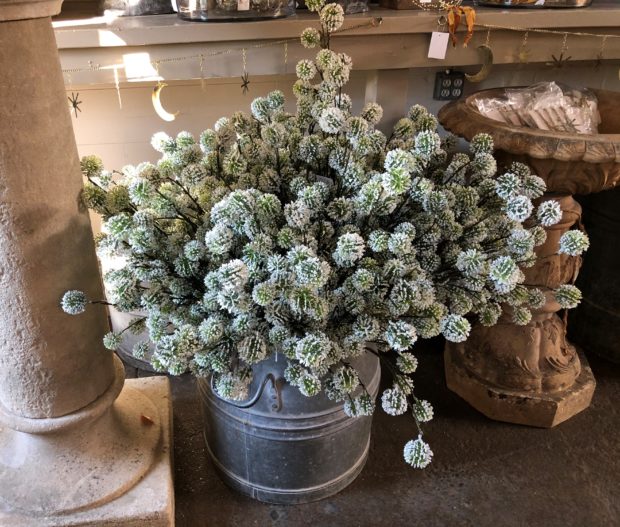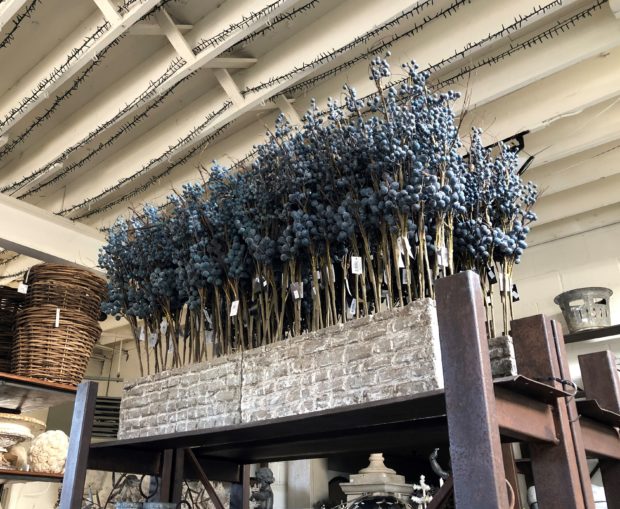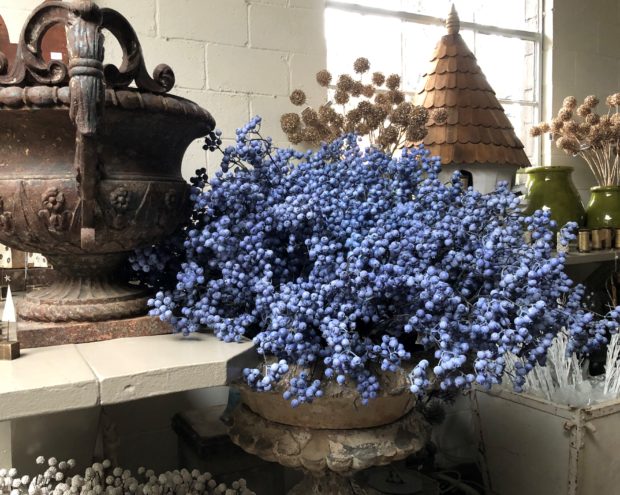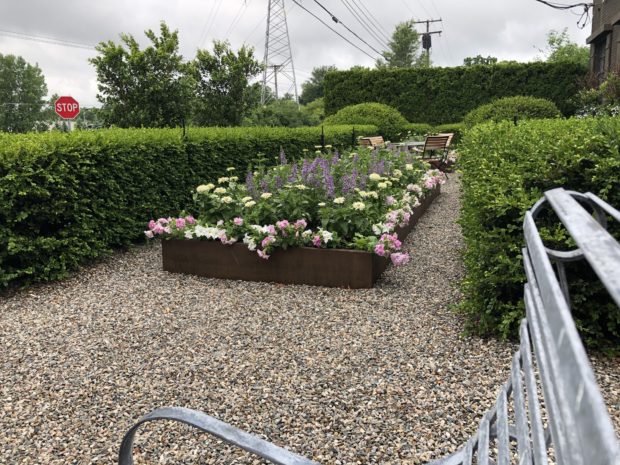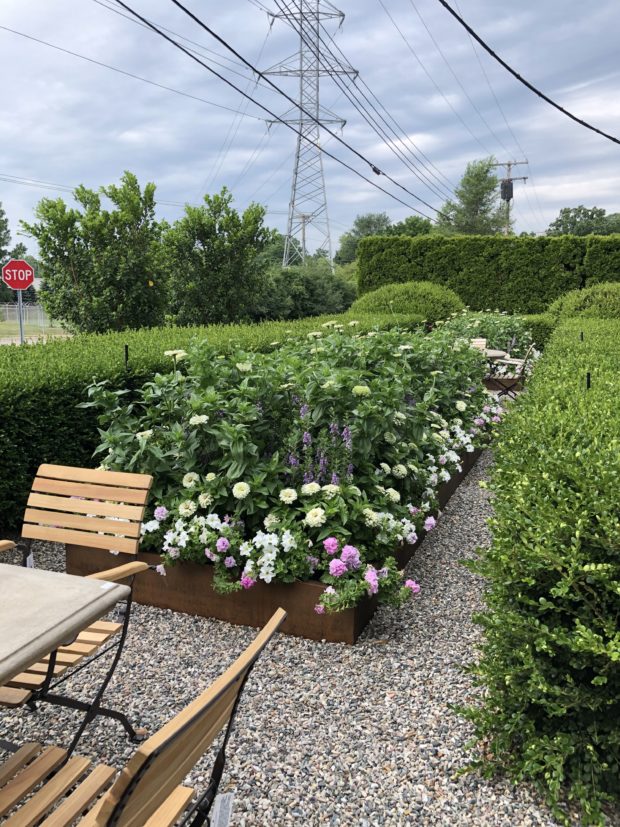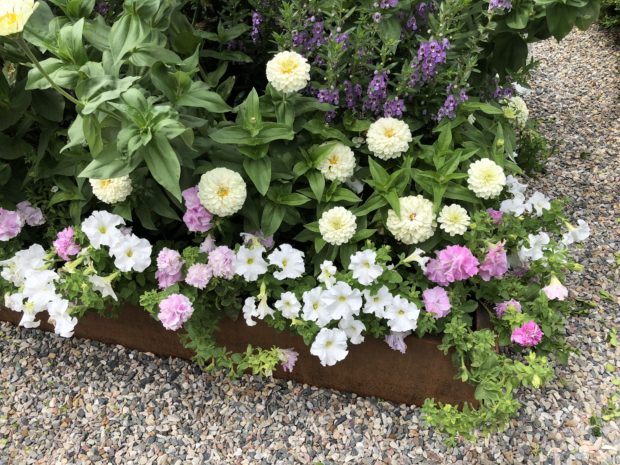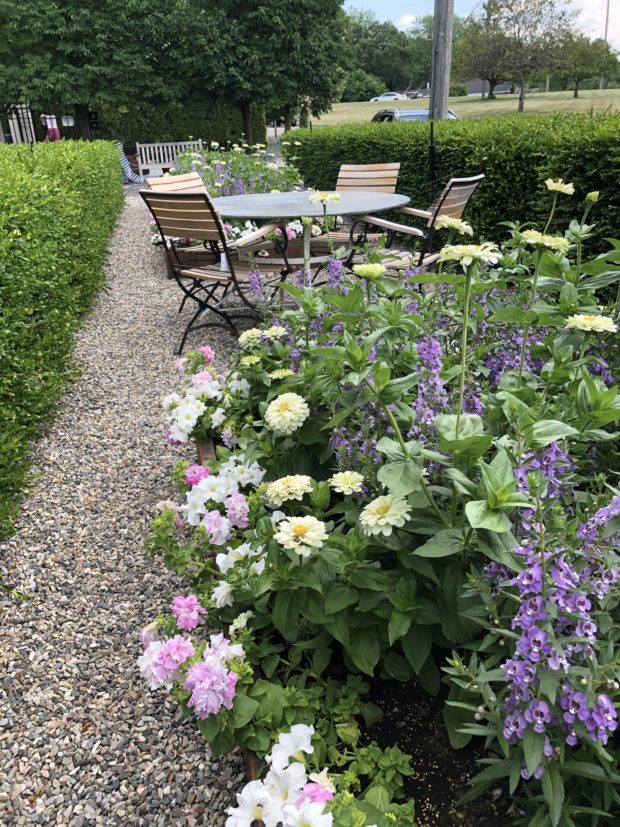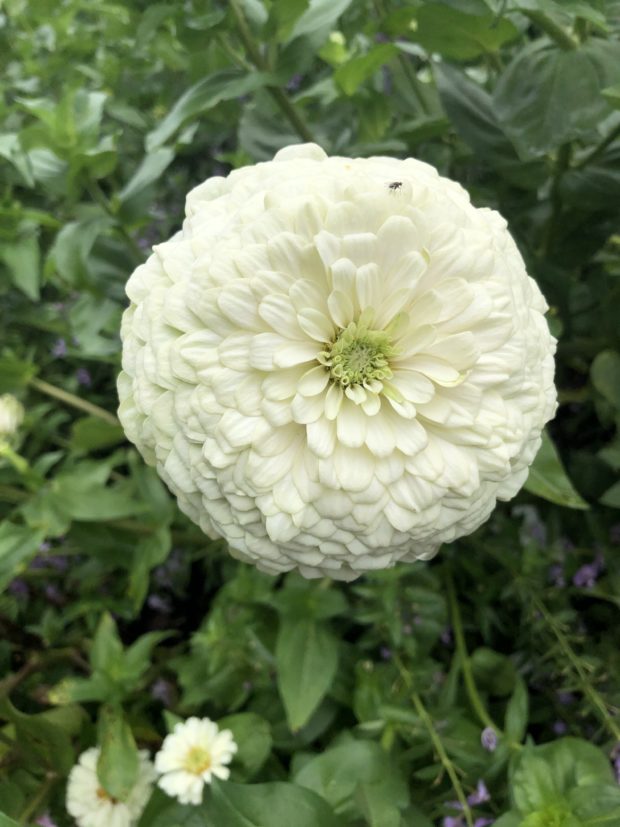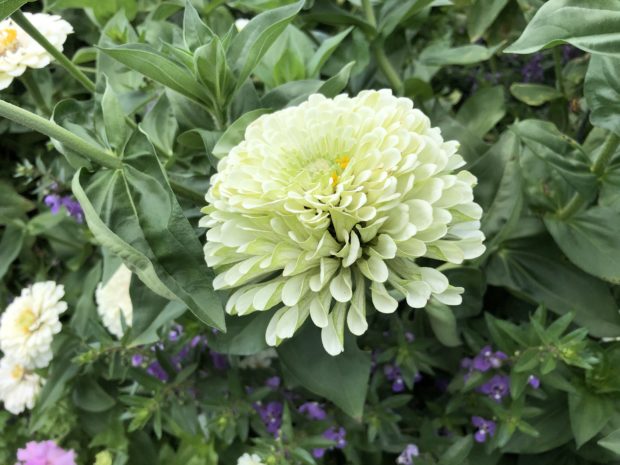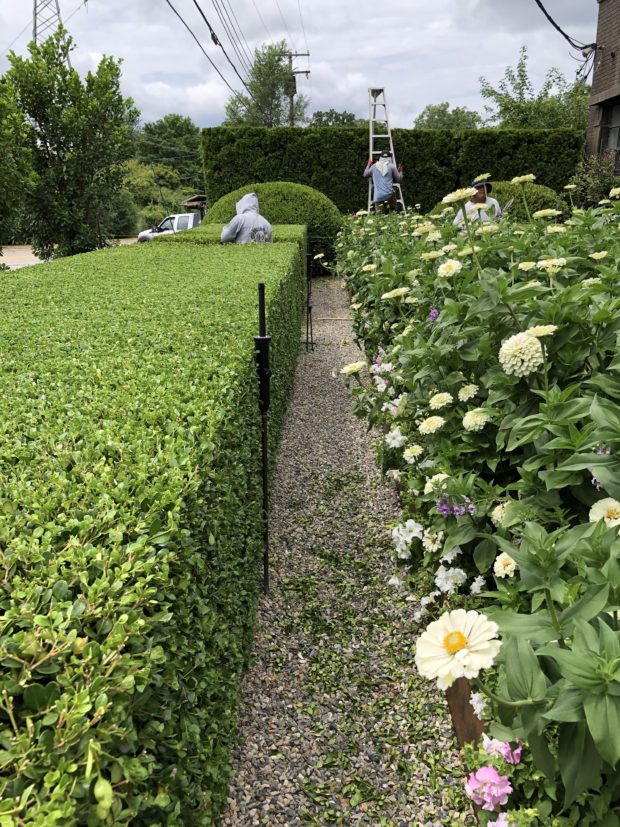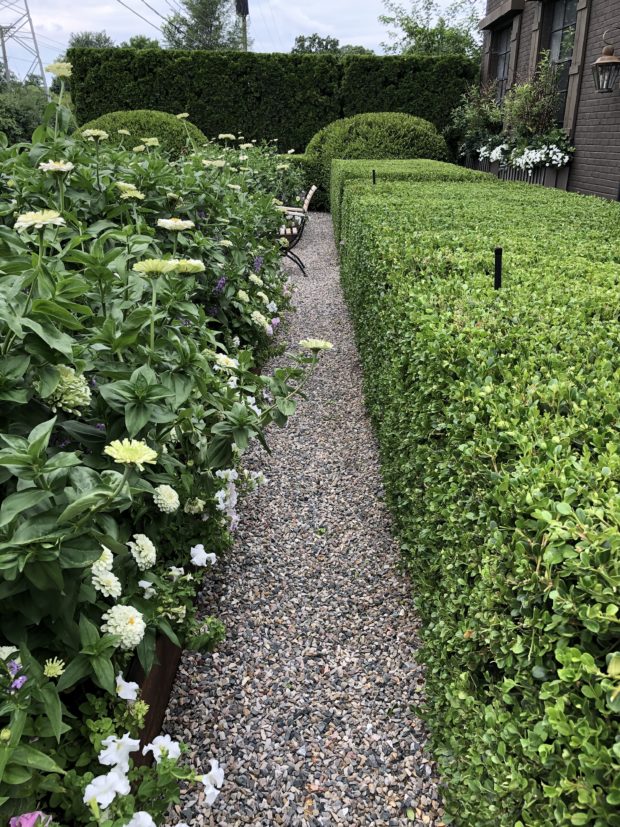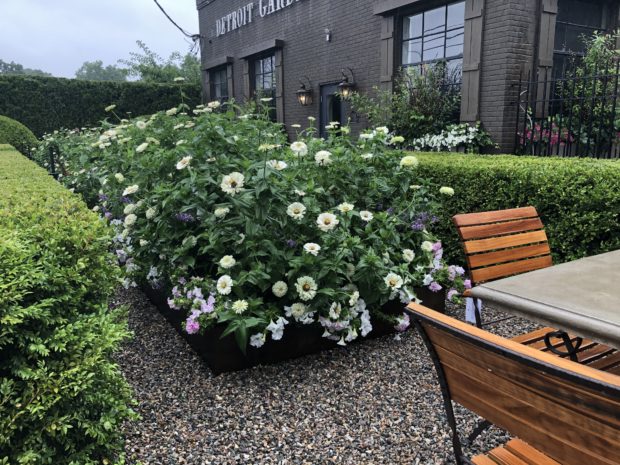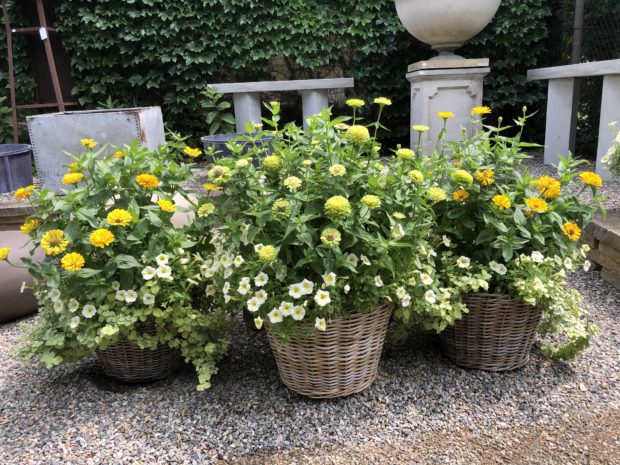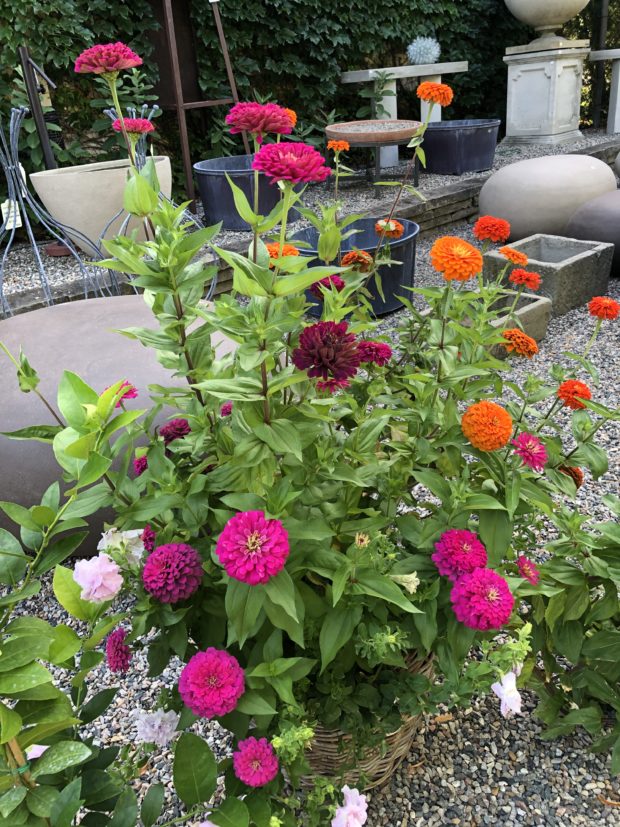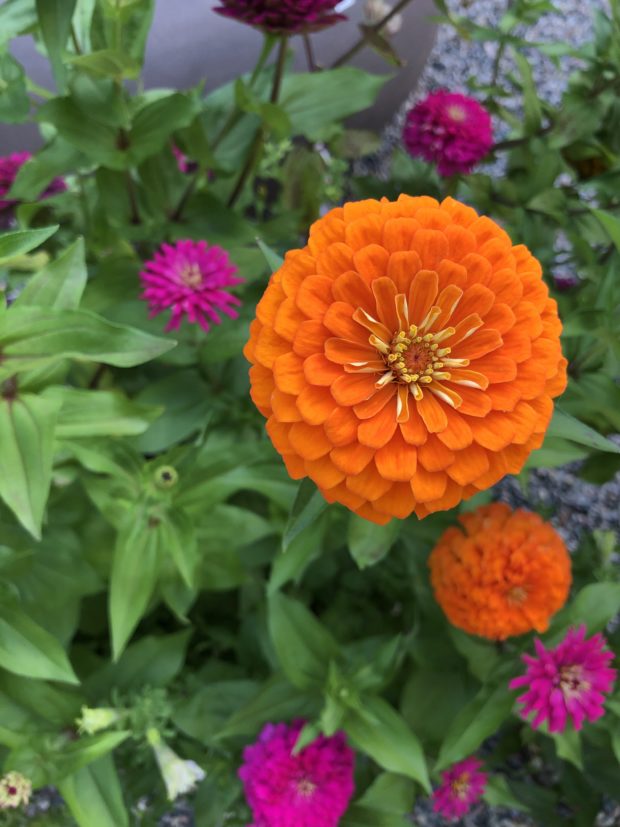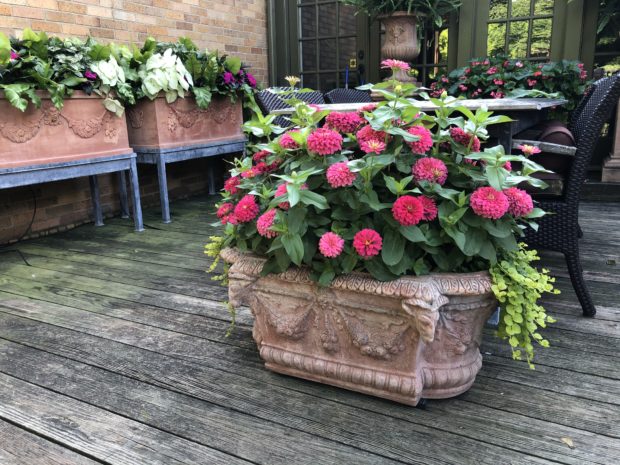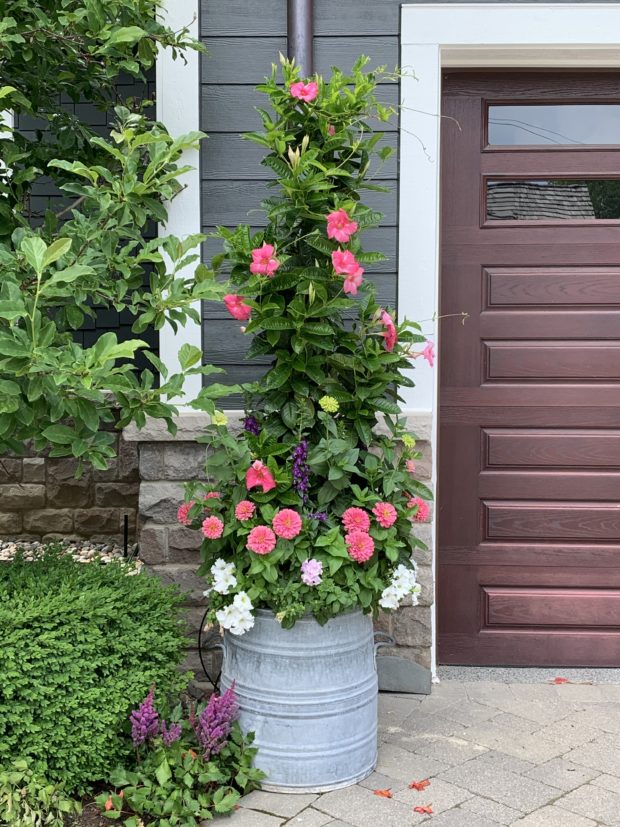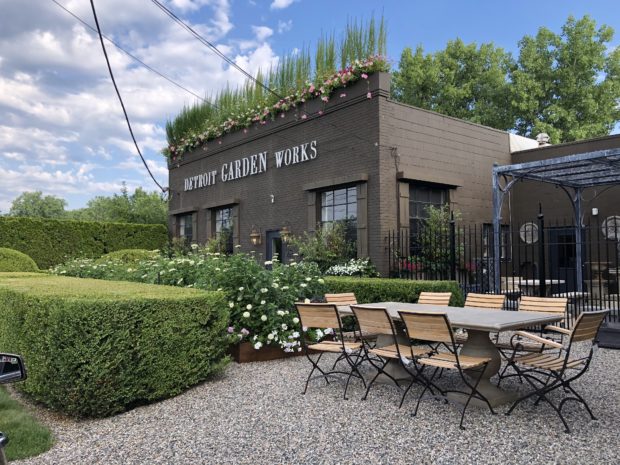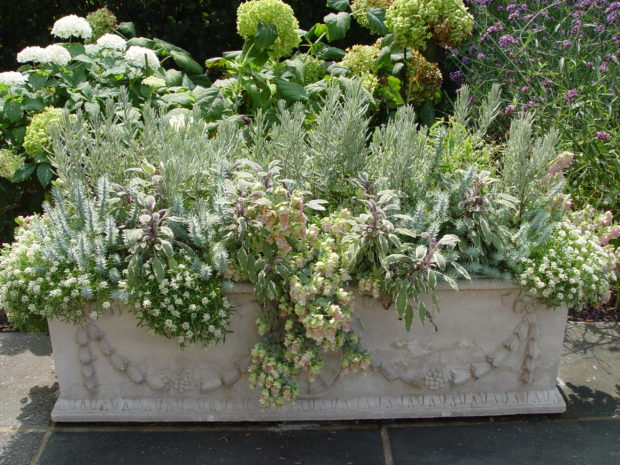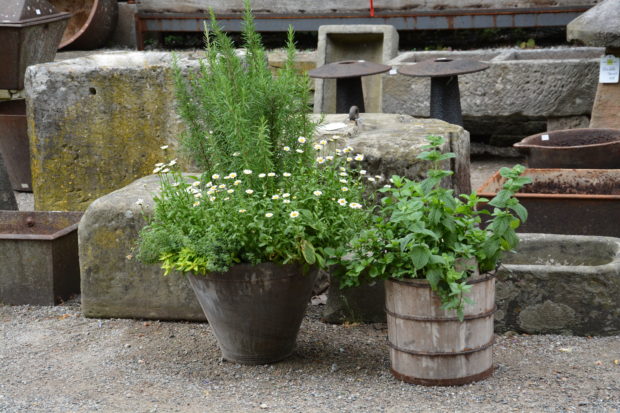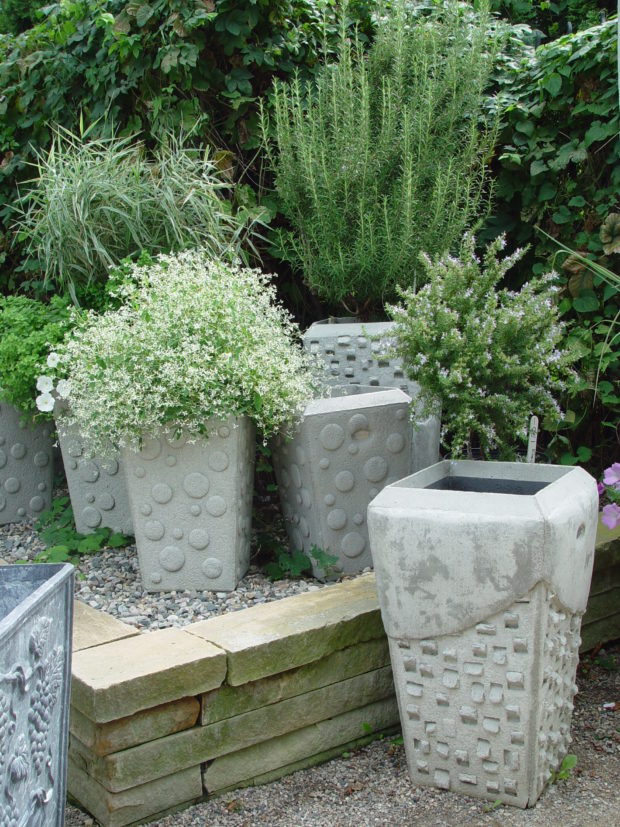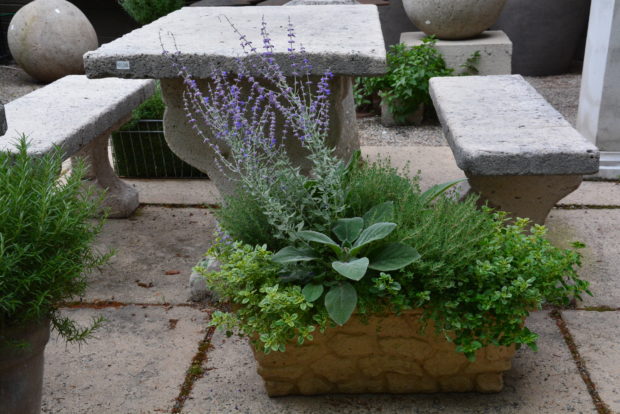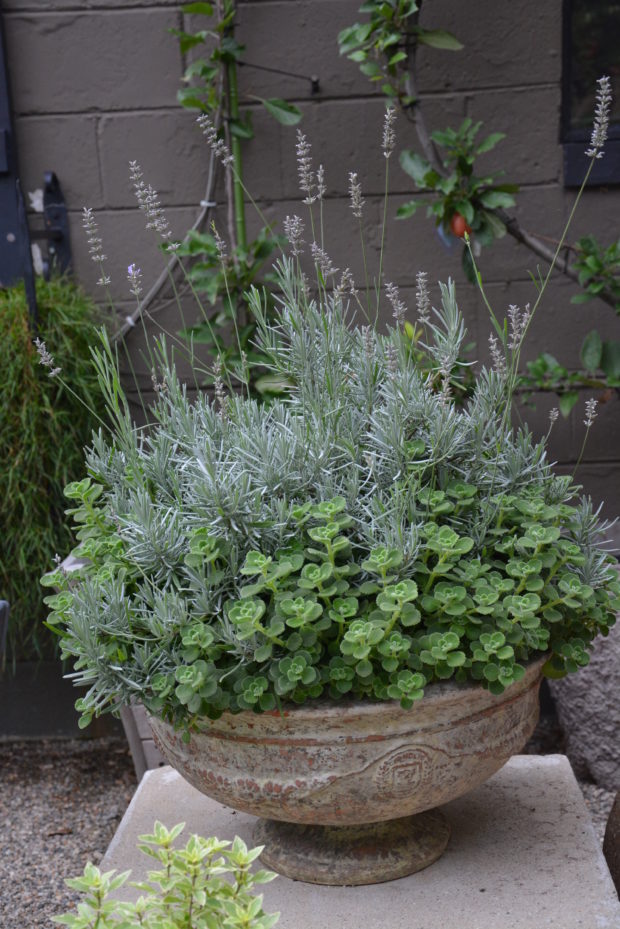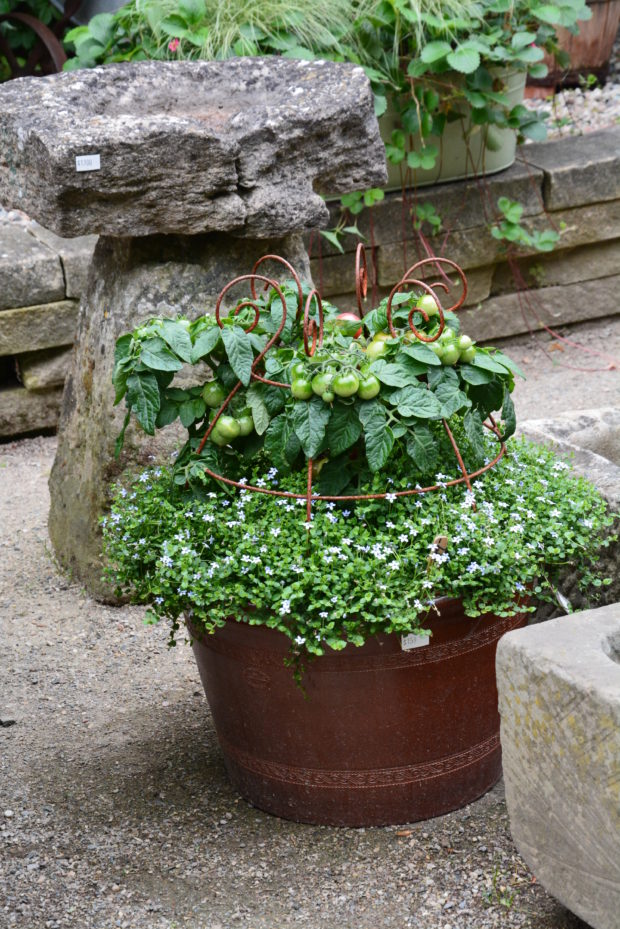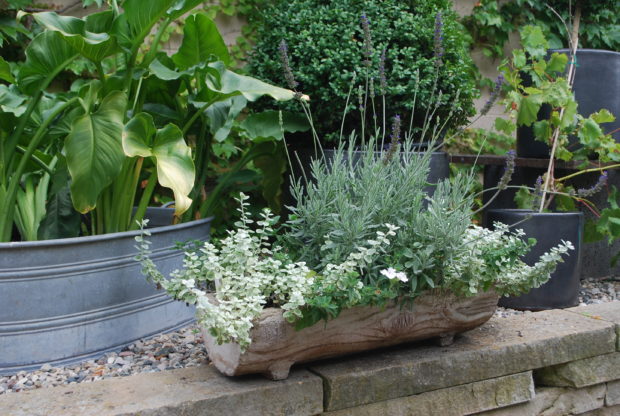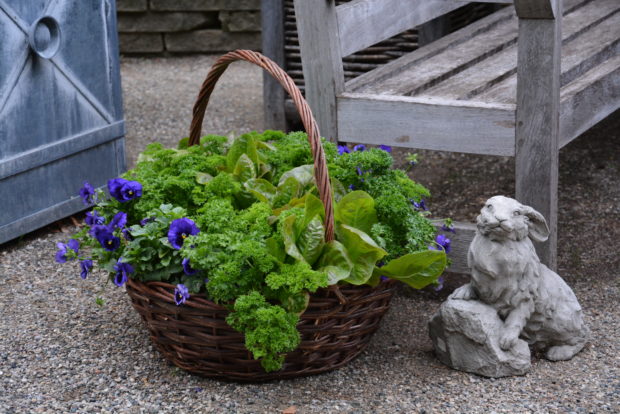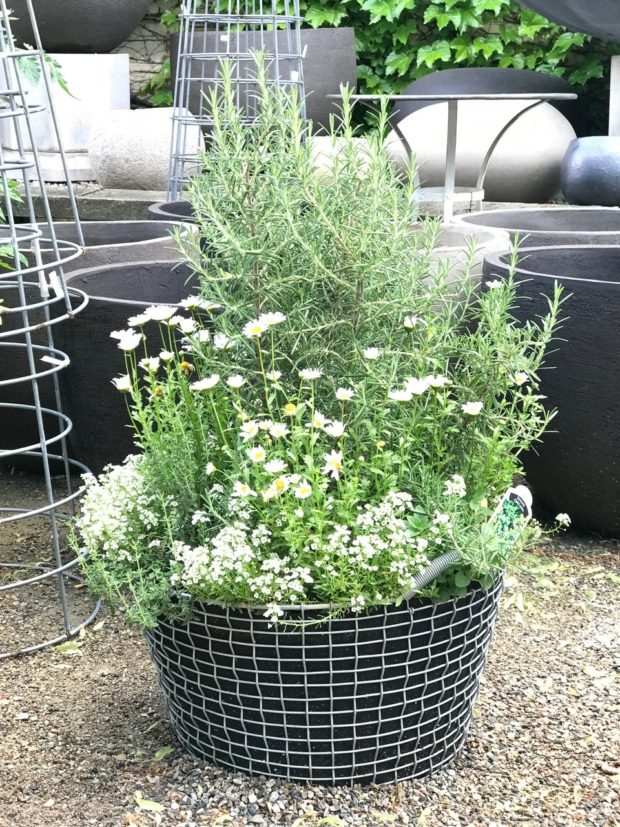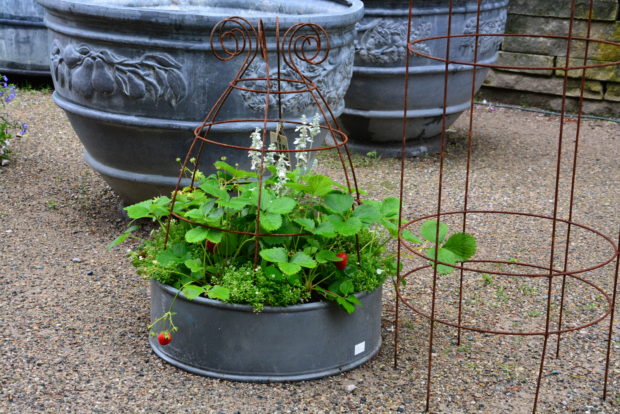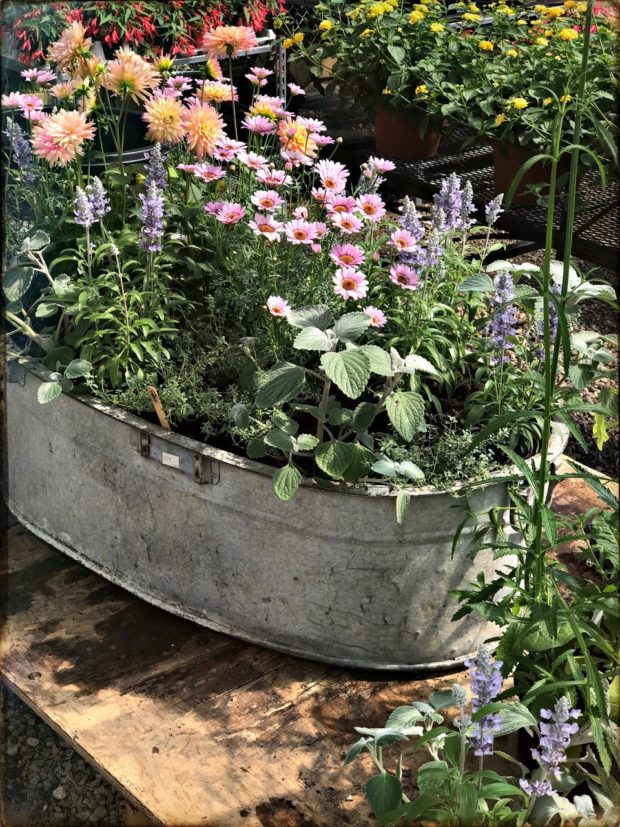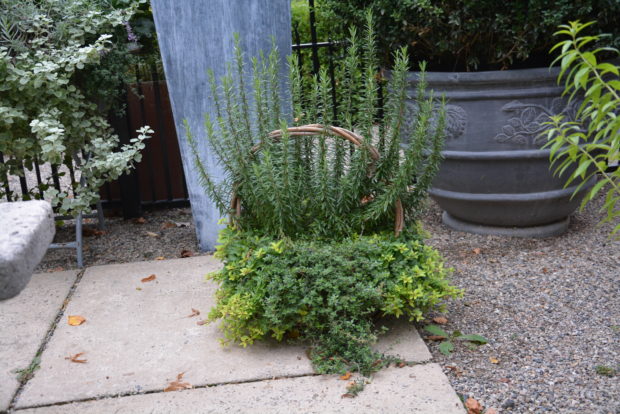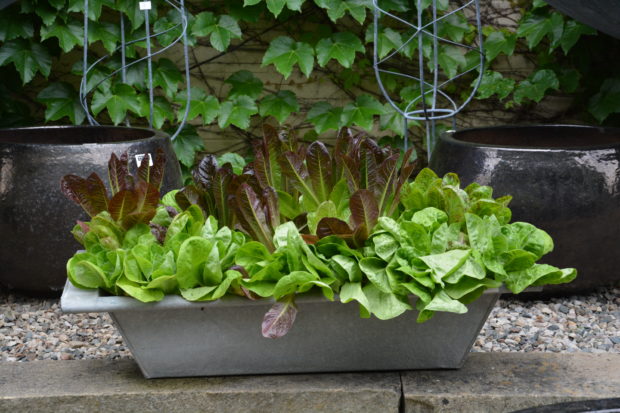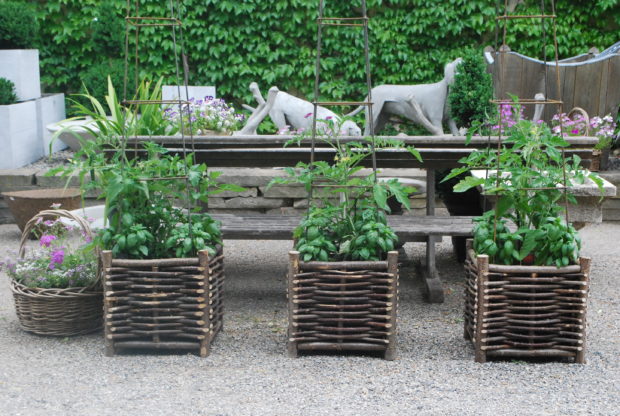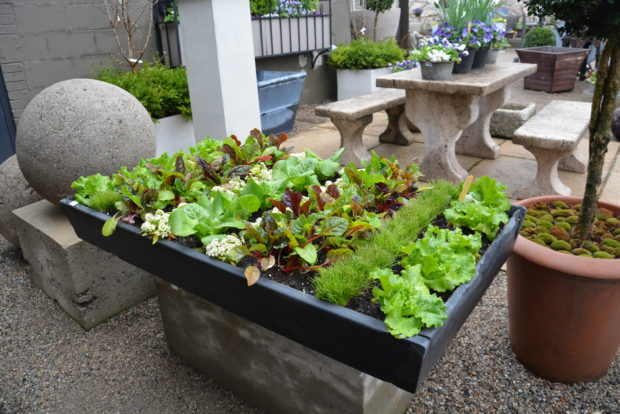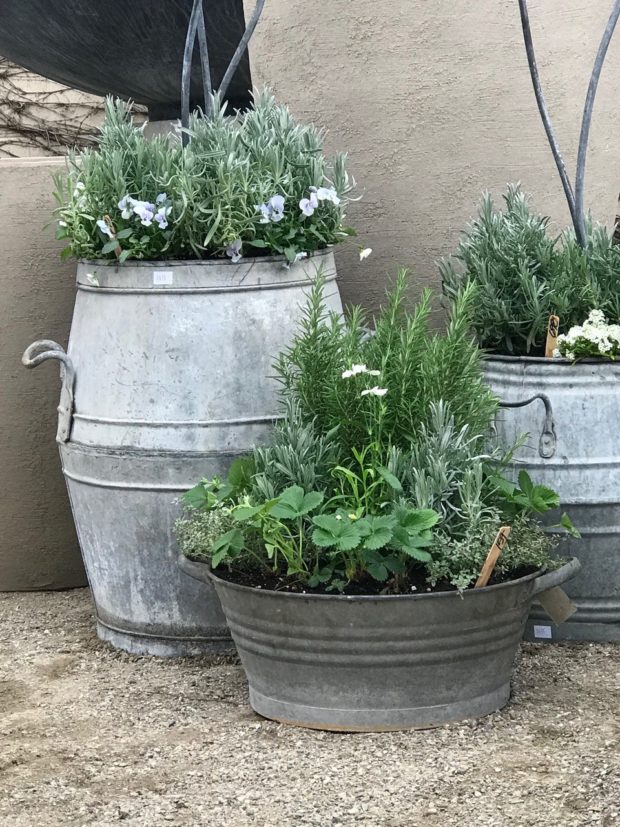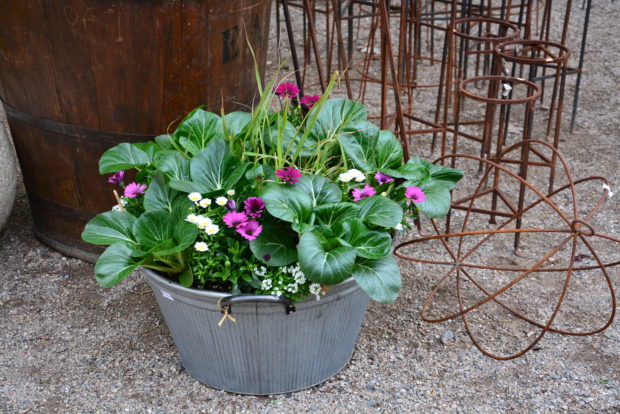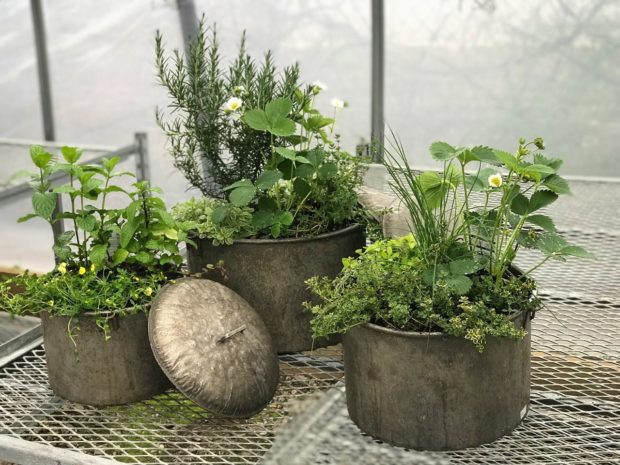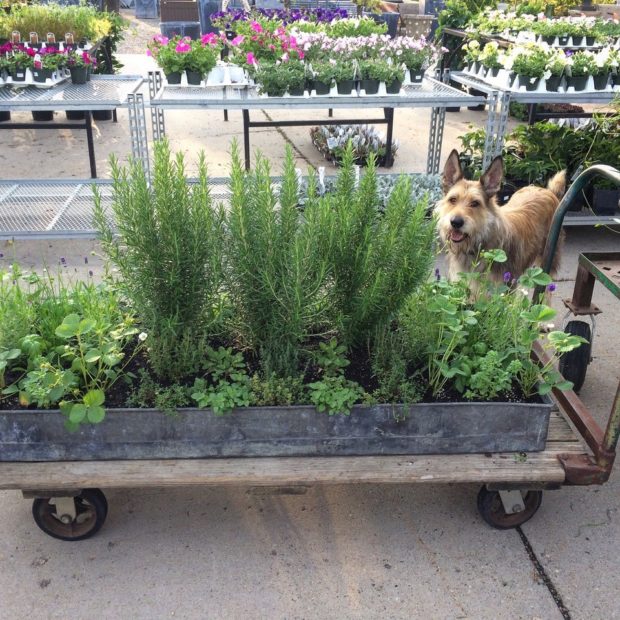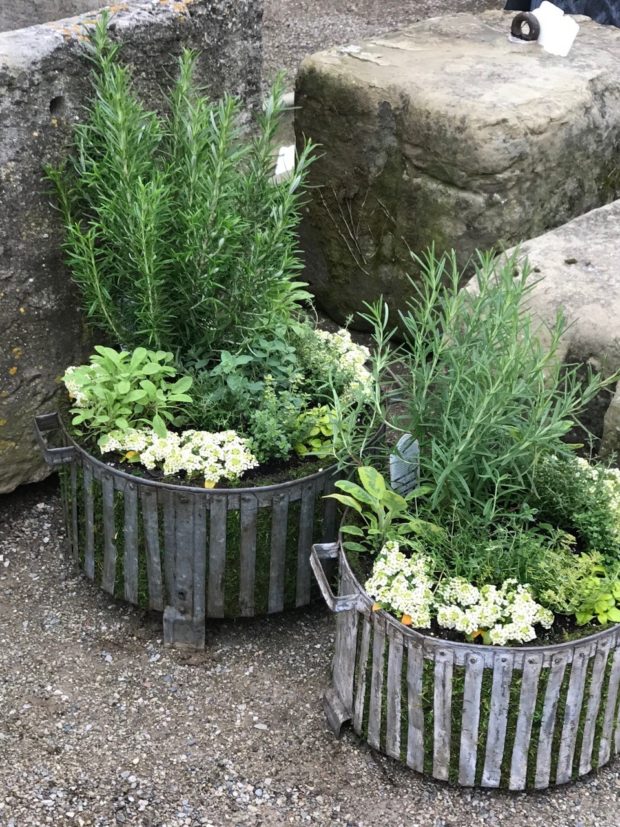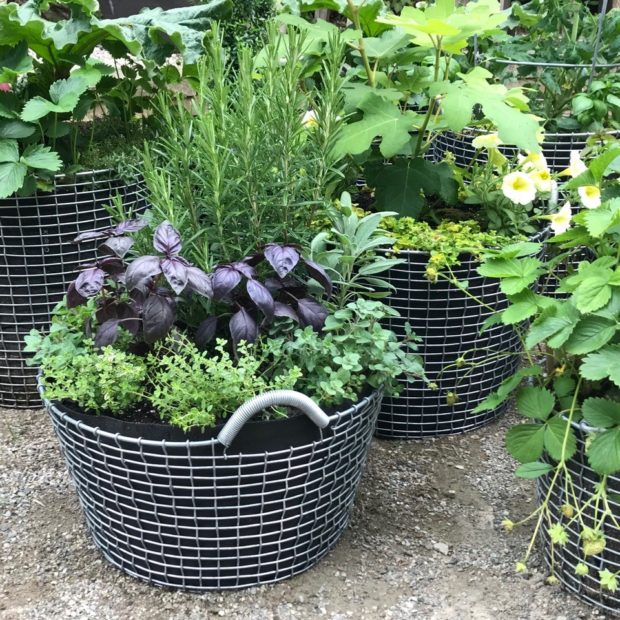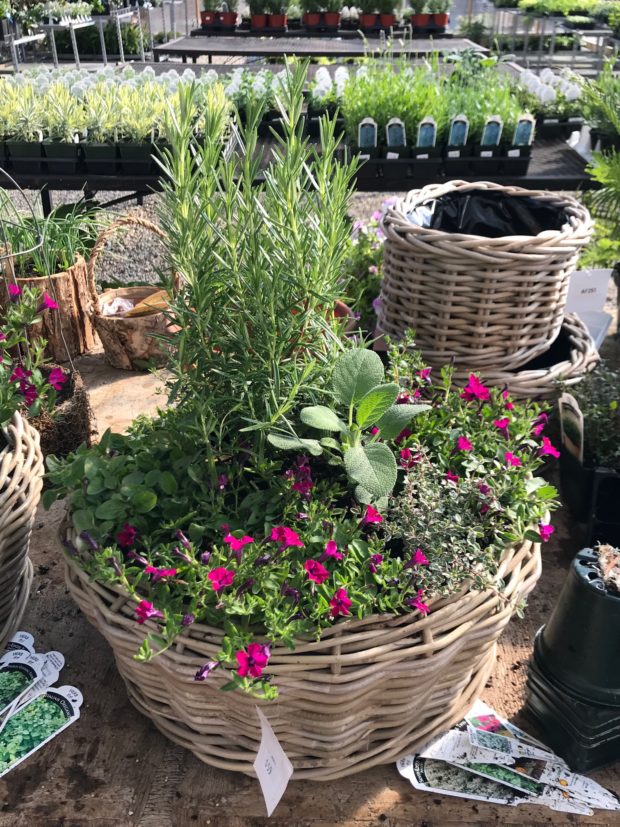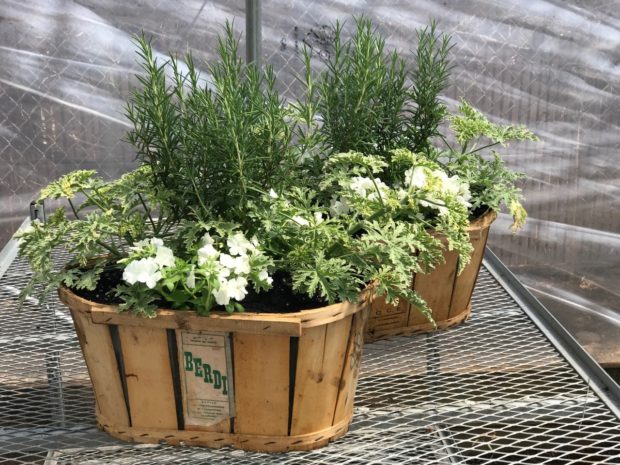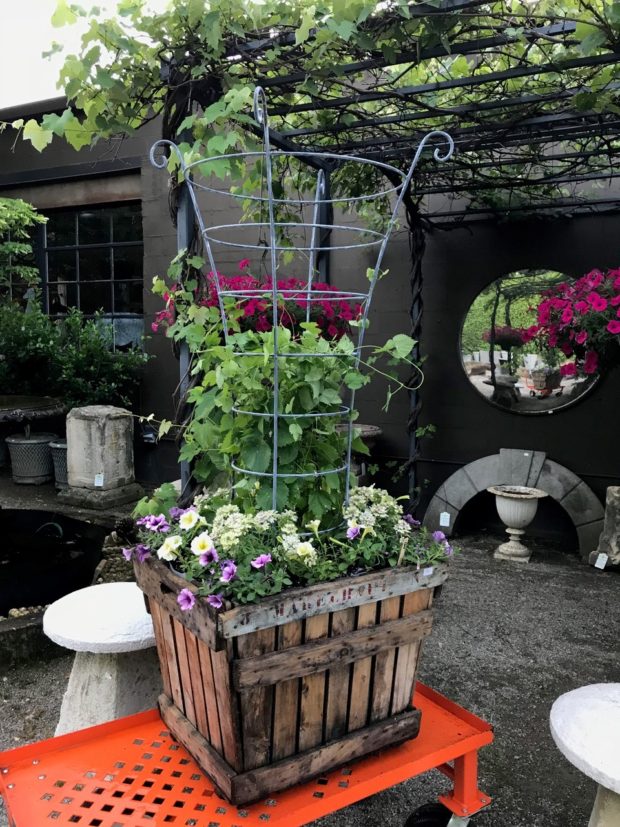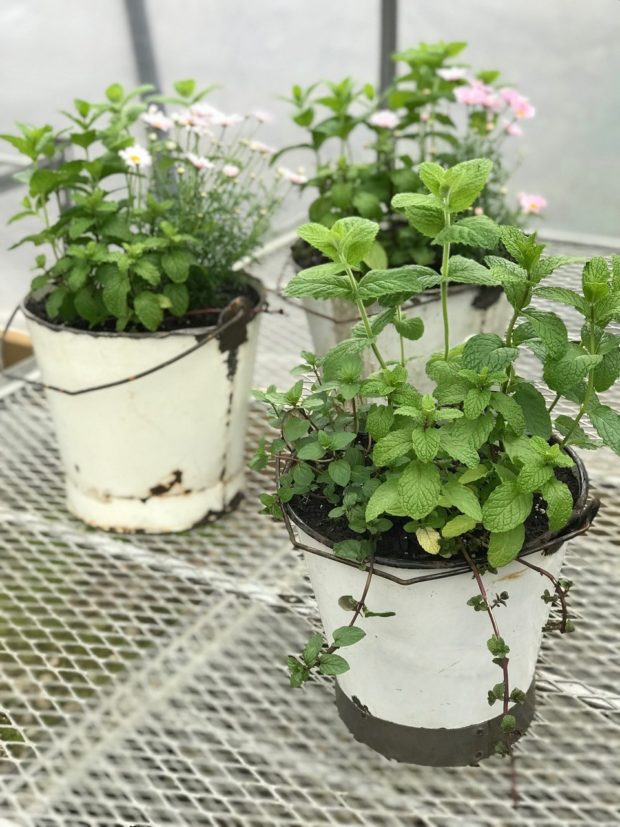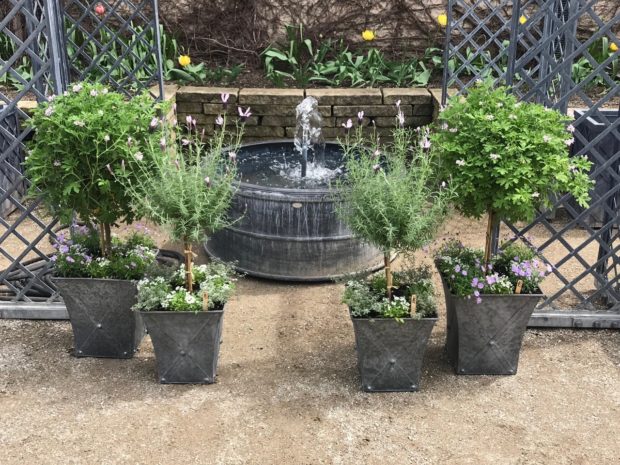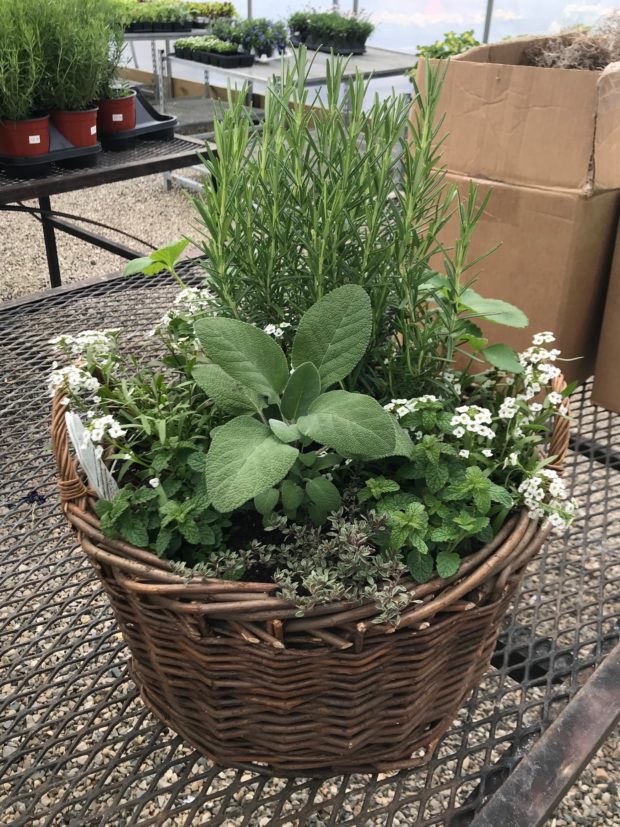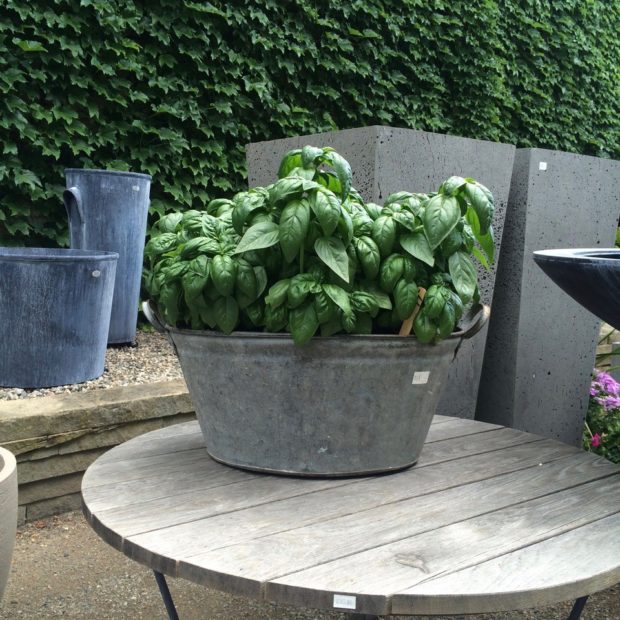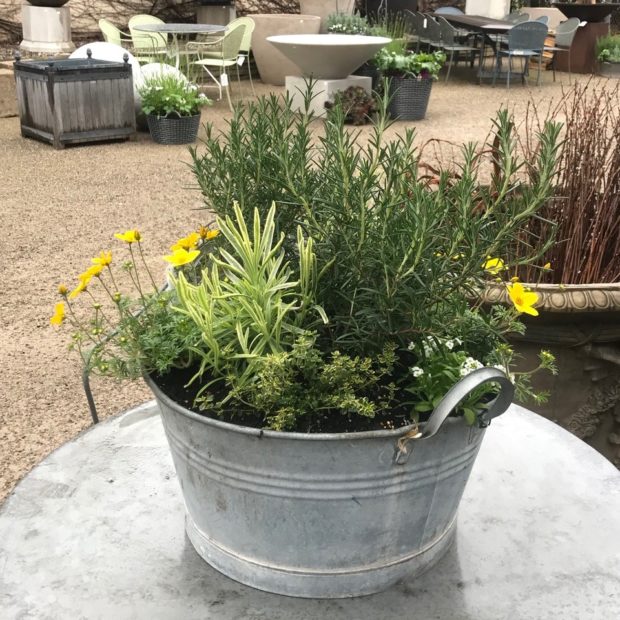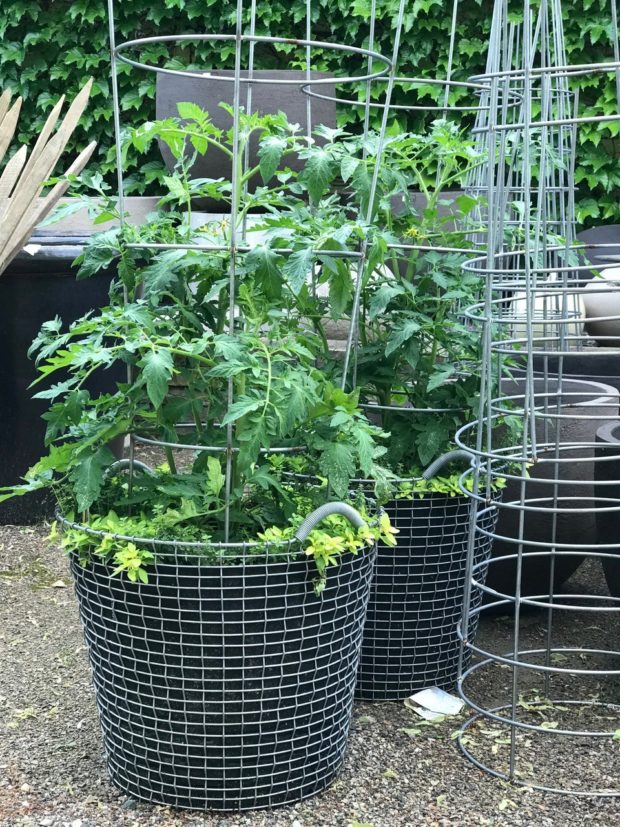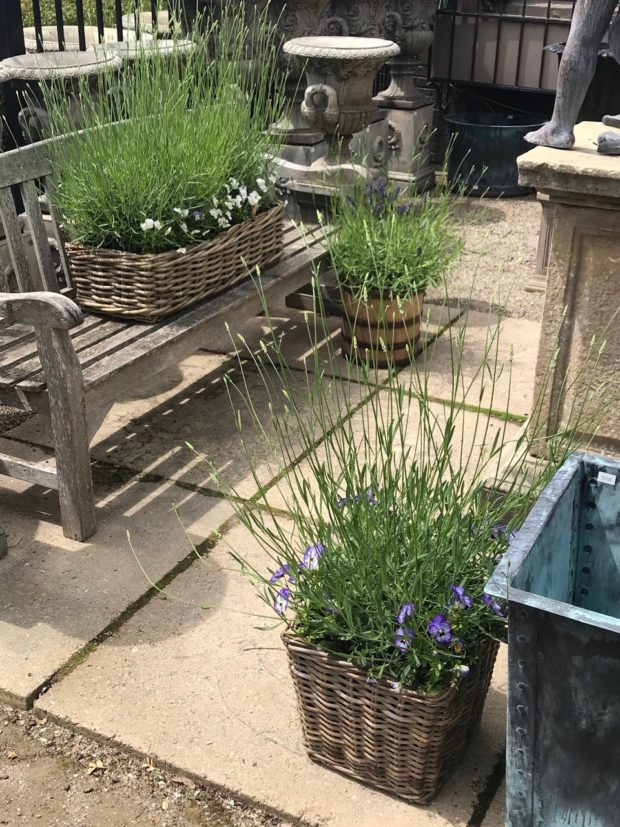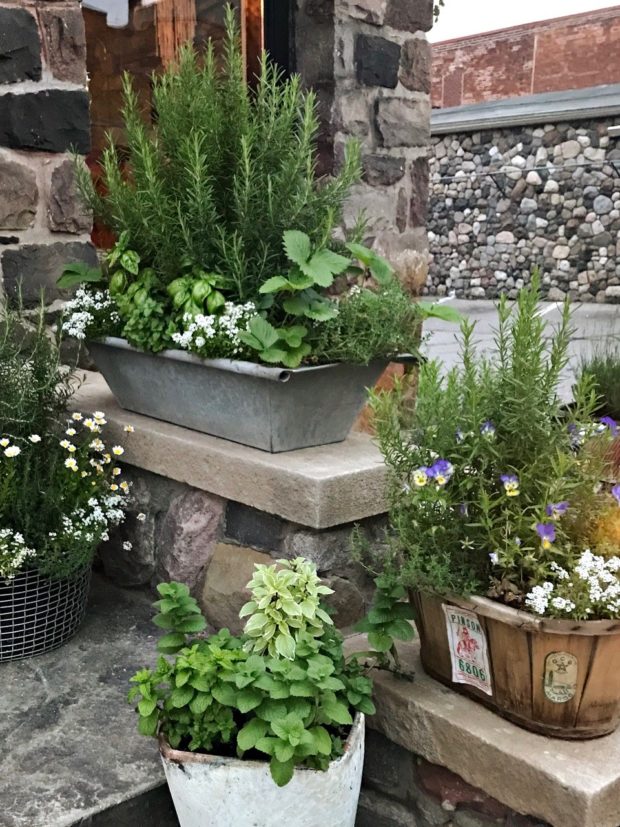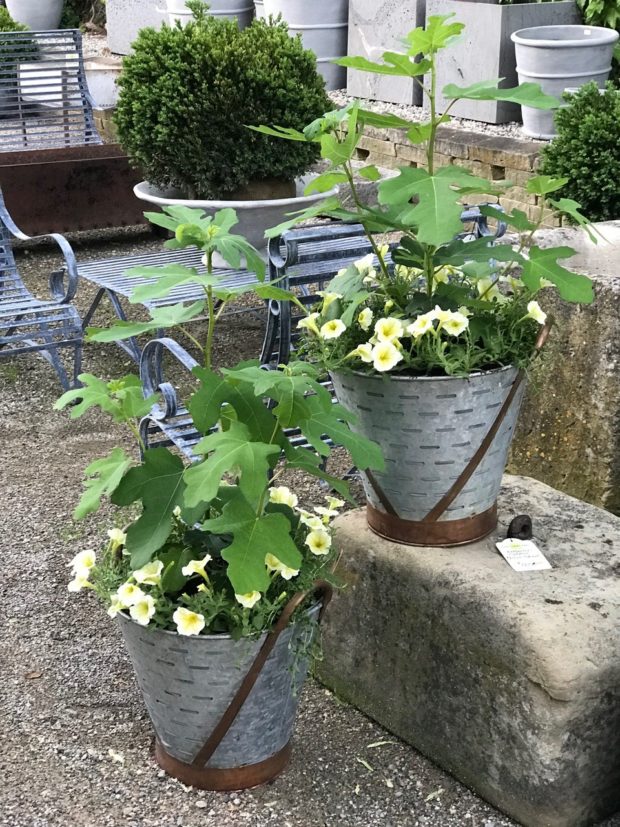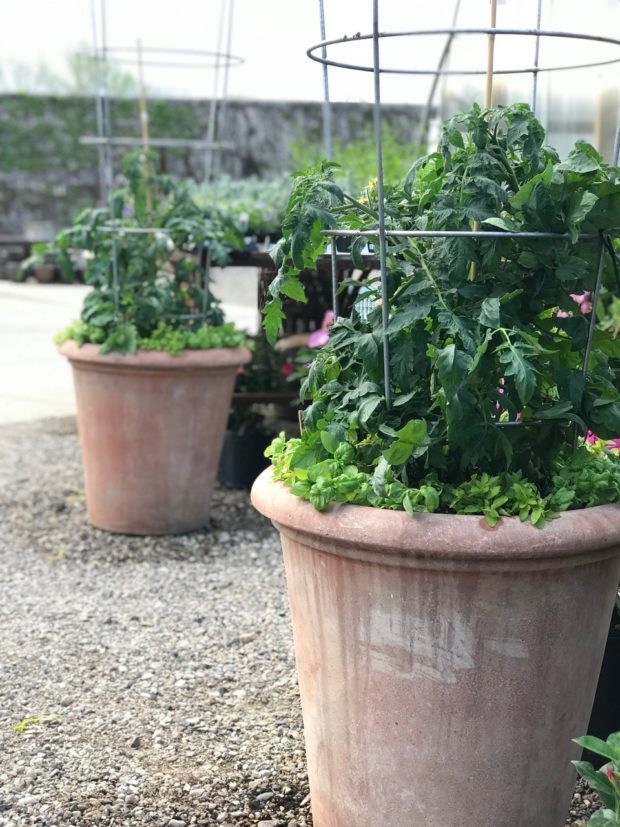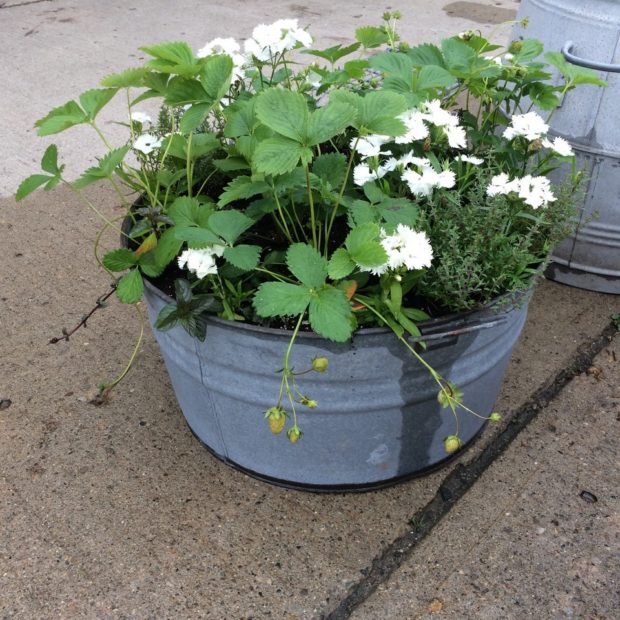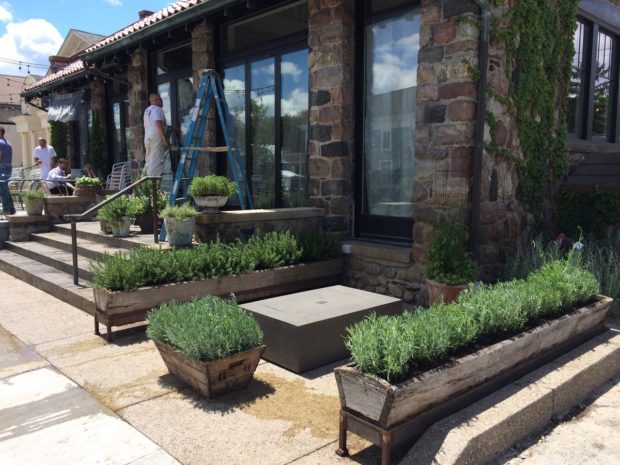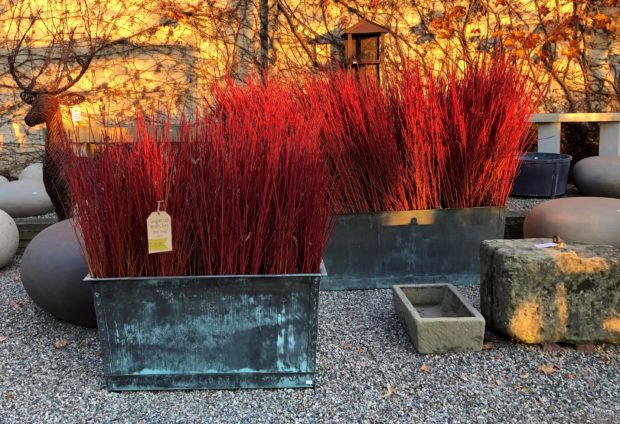 I have been writing about the design, construction and installation of our winter pots in great detail for a good many years. I have done so for several reasons. First and foremost, I believe the transmission of knowledge and process is something every person should do, if they are able. I also think that our approach to the work is unique, in that we treat the arrangements as sculpture. To see the sculpture in them is to understand how we design and make them. I am all for beautiful winter pots in evidence everywhere. Beautiful container sculpture in the winter landscape enriches everyone who sees them. All of the elements have to be integrated at a finished size-as winter pots do not grow. They endure, over 4 or 5 months of the toughest weather we have – the winter. Like a great landscape, a great winter arrangement depends on it’s interior structure. But designing the structure comes after all of the other design decisions are made. Consider every element your would ordinarily consider, designing a container-as in color, shape, texture, line, mass, volume, and proportion. But my first consideration is always the materials.
I have been writing about the design, construction and installation of our winter pots in great detail for a good many years. I have done so for several reasons. First and foremost, I believe the transmission of knowledge and process is something every person should do, if they are able. I also think that our approach to the work is unique, in that we treat the arrangements as sculpture. To see the sculpture in them is to understand how we design and make them. I am all for beautiful winter pots in evidence everywhere. Beautiful container sculpture in the winter landscape enriches everyone who sees them. All of the elements have to be integrated at a finished size-as winter pots do not grow. They endure, over 4 or 5 months of the toughest weather we have – the winter. Like a great landscape, a great winter arrangement depends on it’s interior structure. But designing the structure comes after all of the other design decisions are made. Consider every element your would ordinarily consider, designing a container-as in color, shape, texture, line, mass, volume, and proportion. But my first consideration is always the materials.
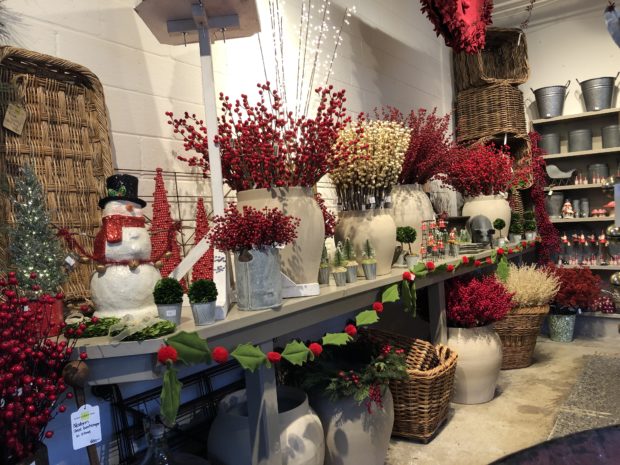 I am certainly a spoiled brat when it comes to materials. Rob shops all year round for what ends up being a whole store’s worth of beautiful materials. I can do all of my shopping in one convenient location. (yes, Deborah Silver and Company purchases its materials from Detroit Garden Works) I can find faux picks of every description and style, from astonishingly natural berry picks, to glamorous gold plastic grasses. The picks come in all lengths, most of which can be fluffed out, shortened, elongated via a bamboo stake, or cut up – depending on the intended design. What is available to me, and everyone else who shops the Works? There is a wide array of natural fresh cut willow and dogwood branches in a variety of colors, textures and heights. One of my favorites are the densely twiggy and dark alder branches. Magnolia branches in varying lengths and leaf sizes are a specialty of the house. Fresh cut greens include the giant leaved German boxwood, noble fir, pine, juniper, incense and Port Orford cedar, and variegated boxwood-by the bunch or by the case. Rob buys in a considerable collection of exterior lighting that can easily be integrated into a winter arrangement. There is nothing quite like a pair of winter pots lighting the landscape. So what materials will get chosen for a particular pot?
I am certainly a spoiled brat when it comes to materials. Rob shops all year round for what ends up being a whole store’s worth of beautiful materials. I can do all of my shopping in one convenient location. (yes, Deborah Silver and Company purchases its materials from Detroit Garden Works) I can find faux picks of every description and style, from astonishingly natural berry picks, to glamorous gold plastic grasses. The picks come in all lengths, most of which can be fluffed out, shortened, elongated via a bamboo stake, or cut up – depending on the intended design. What is available to me, and everyone else who shops the Works? There is a wide array of natural fresh cut willow and dogwood branches in a variety of colors, textures and heights. One of my favorites are the densely twiggy and dark alder branches. Magnolia branches in varying lengths and leaf sizes are a specialty of the house. Fresh cut greens include the giant leaved German boxwood, noble fir, pine, juniper, incense and Port Orford cedar, and variegated boxwood-by the bunch or by the case. Rob buys in a considerable collection of exterior lighting that can easily be integrated into a winter arrangement. There is nothing quite like a pair of winter pots lighting the landscape. So what materials will get chosen for a particular pot?
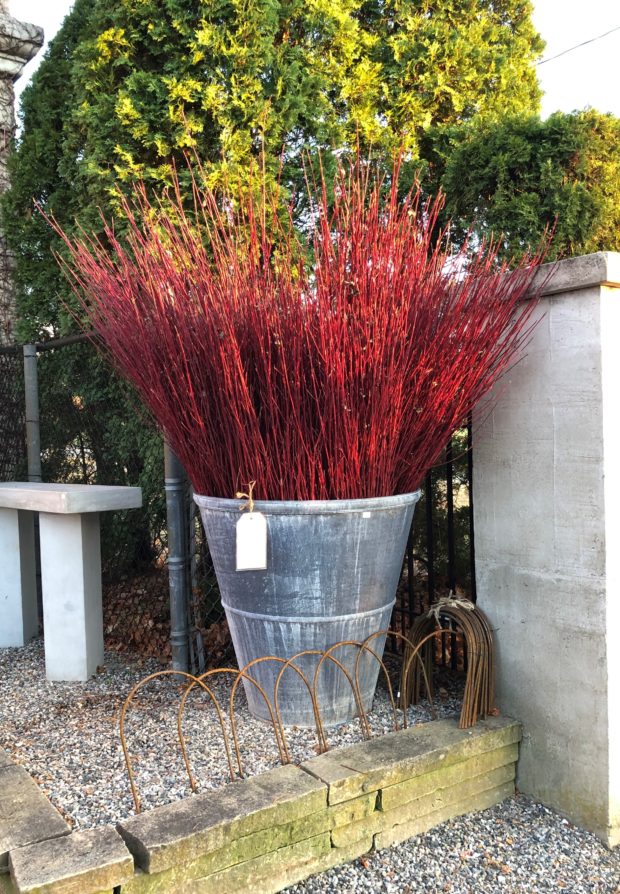 The materials I choose has everything to do with the taste of the client. Everyone likes something different. Sometimes I just stand in the shop and watch what people pick. Since one of my crews does the display at the shop for holiday and winter, I have plenty of time to become acquainted with what we have available. More often than not, what I do at home has to do with what materials are left the end of December. I really don’t mind this, as something beautiful can always be done with beautiful materials.
The materials I choose has everything to do with the taste of the client. Everyone likes something different. Sometimes I just stand in the shop and watch what people pick. Since one of my crews does the display at the shop for holiday and winter, I have plenty of time to become acquainted with what we have available. More often than not, what I do at home has to do with what materials are left the end of December. I really don’t mind this, as something beautiful can always be done with beautiful materials.
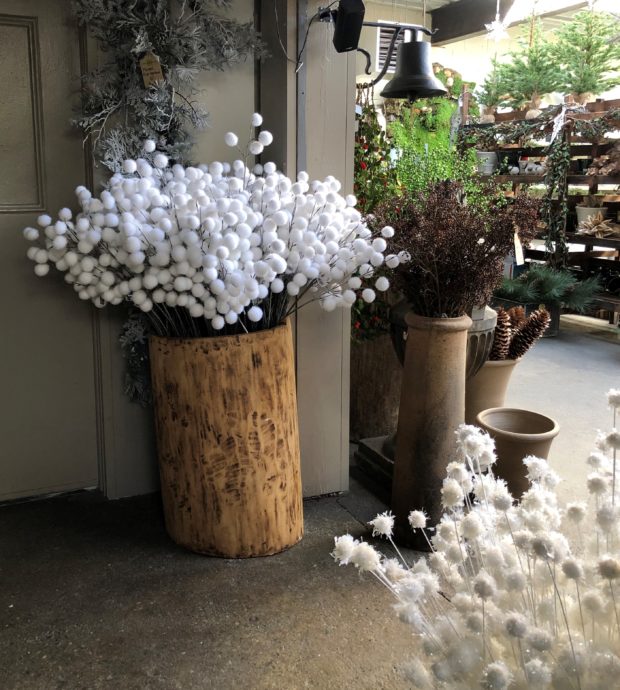 But where I do make decisions about materials has to do with how they relate to one another. Some colors are eye catching or rhythmic together. Very dark colors paired with white make for some drama. Similar colors make for subtle relationships. All the same color can shift the focus from the color to the overall form of the arrangement. Some color pairings cancel each other out, or vigorously clash. All colors are beautiful-they just need proper accompaniment. And who decides what’s proper? It’s a matter of taste. If I see a client going off the road and into the weeds, I will say something. That’s part of the job. But plenty of times I have been surprised to see what I never thought would work very well turn out lovely. That’s why more than one pair of eyes on a project can be a good thing.
But where I do make decisions about materials has to do with how they relate to one another. Some colors are eye catching or rhythmic together. Very dark colors paired with white make for some drama. Similar colors make for subtle relationships. All the same color can shift the focus from the color to the overall form of the arrangement. Some color pairings cancel each other out, or vigorously clash. All colors are beautiful-they just need proper accompaniment. And who decides what’s proper? It’s a matter of taste. If I see a client going off the road and into the weeds, I will say something. That’s part of the job. But plenty of times I have been surprised to see what I never thought would work very well turn out lovely. That’s why more than one pair of eyes on a project can be a good thing.
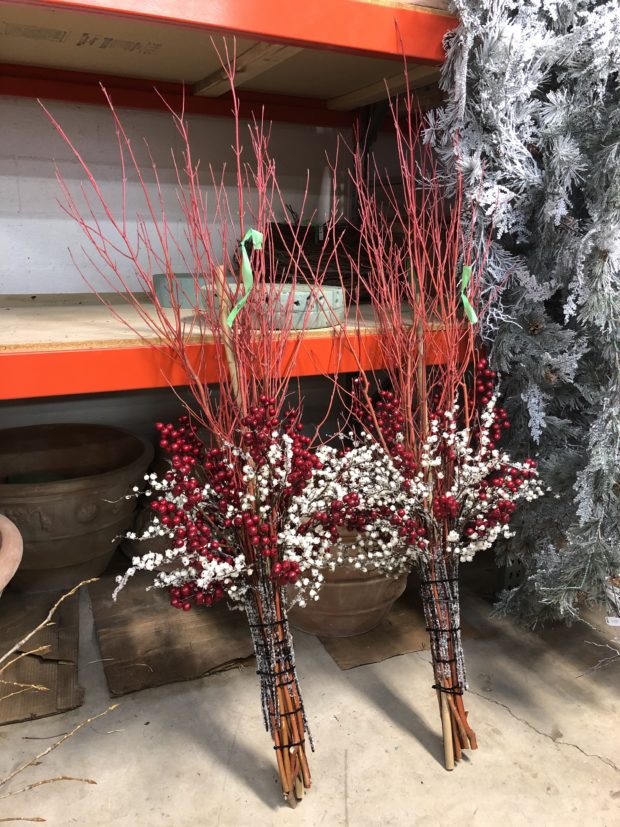 This collection of red and white materials contrasts strongly, but I know that once it is outside, and nestled in a bed of noble fir, it will look festive. Once the greens have a dusting of snow, it will look like a holiday is going on. A consideration of materials is very much about how those materials will look outdoors in their intended home.
This collection of red and white materials contrasts strongly, but I know that once it is outside, and nestled in a bed of noble fir, it will look festive. Once the greens have a dusting of snow, it will look like a holiday is going on. A consideration of materials is very much about how those materials will look outdoors in their intended home.
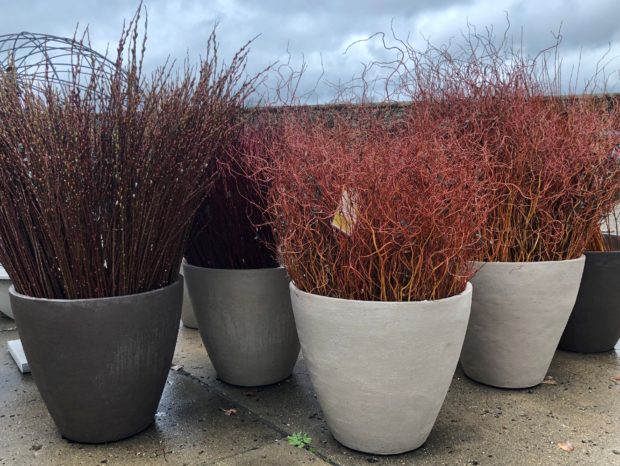 Even though I have lots of choices for materials, it does not mean I want to use all of them in the same pot. Once materials are chosen, it’s time to edit out those materials that don’t add something significant to the relationshIps established by color, shape, texture or mass. Editing is the most difficult part of designing. If there are 10 materials you can’t do without, do 2 or 3 containers instead of one.
Even though I have lots of choices for materials, it does not mean I want to use all of them in the same pot. Once materials are chosen, it’s time to edit out those materials that don’t add something significant to the relationshIps established by color, shape, texture or mass. Editing is the most difficult part of designing. If there are 10 materials you can’t do without, do 2 or 3 containers instead of one.
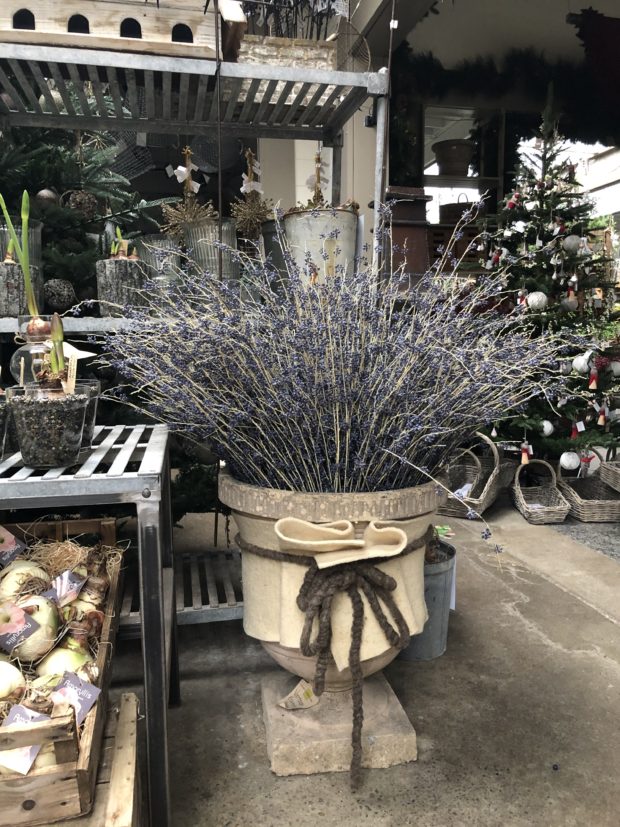 There is certainly something to be said for a huge mass of one material. In the case of these blueberry colored picks, the subtle color will not read unless you use lots, and the pot is likely to be viewed up close. 20 of these picks out in the side yard will not read. Nor will a hundred. The small size and moody color will go gray with the distance. Up close to the front door, the subtle color can be appreciated.
There is certainly something to be said for a huge mass of one material. In the case of these blueberry colored picks, the subtle color will not read unless you use lots, and the pot is likely to be viewed up close. 20 of these picks out in the side yard will not read. Nor will a hundred. The small size and moody color will go gray with the distance. Up close to the front door, the subtle color can be appreciated.
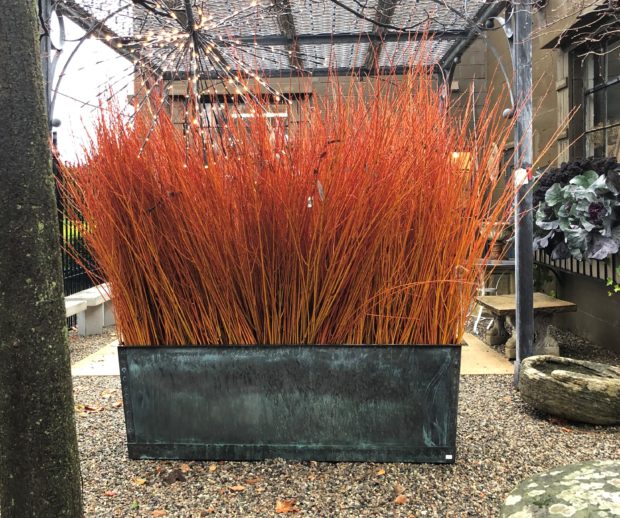 Natural materials have a vibrancy and glow that cannot be replicated with a faux pick – no matter the skill of the manufacturer. I like to design around natural materials in one form or another. Most of the winter containers we do are predominantly natural materials. They are after all, an expression of the winter garden. But that is not to say that a little outright fakery might not be just the thing to bring an idea to life. Or that the investment in a collection of faux berry stems could not grace winter pots for a number of years to come.
Natural materials have a vibrancy and glow that cannot be replicated with a faux pick – no matter the skill of the manufacturer. I like to design around natural materials in one form or another. Most of the winter containers we do are predominantly natural materials. They are after all, an expression of the winter garden. But that is not to say that a little outright fakery might not be just the thing to bring an idea to life. Or that the investment in a collection of faux berry stems could not grace winter pots for a number of years to come.
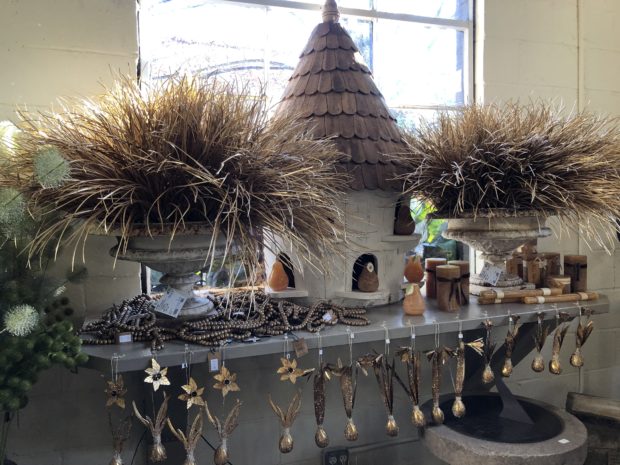 These gold plastic grass picks do beautifully mimic the form and airy texture of real ornamental grasses, with the added attraction of a little winter show and shine. The technology and manufacturing behind the production of these picks is sure evidence of the human hand. And they can be used year after year. The durability outdoors is truly remarkable.
These gold plastic grass picks do beautifully mimic the form and airy texture of real ornamental grasses, with the added attraction of a little winter show and shine. The technology and manufacturing behind the production of these picks is sure evidence of the human hand. And they can be used year after year. The durability outdoors is truly remarkable.
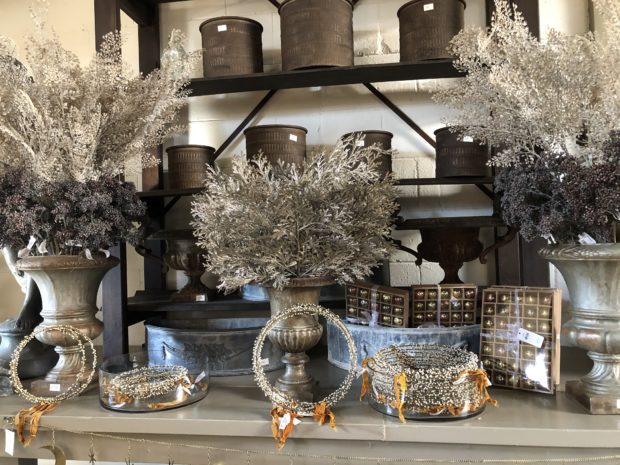 These.platinum picks would be beautiful with fresh cut poplar or beech branches.
These.platinum picks would be beautiful with fresh cut poplar or beech branches.
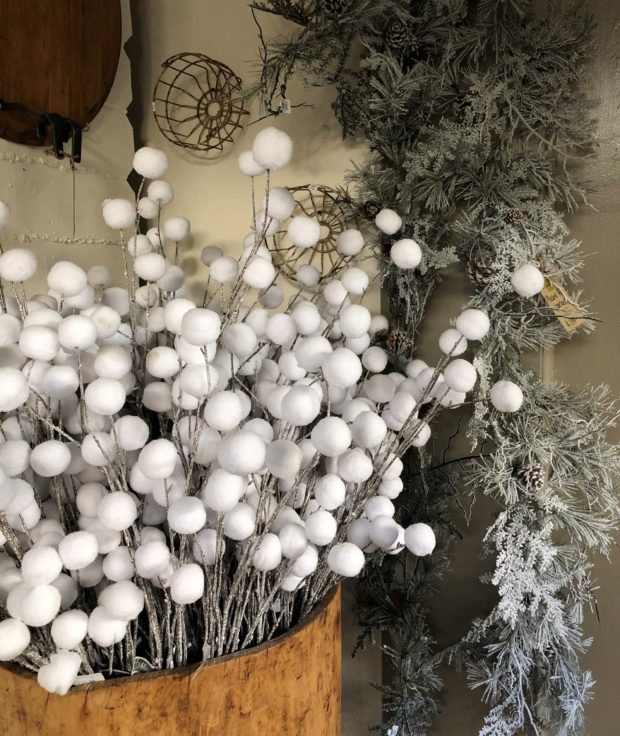 snowball picks on very long stems
snowball picks on very long stems
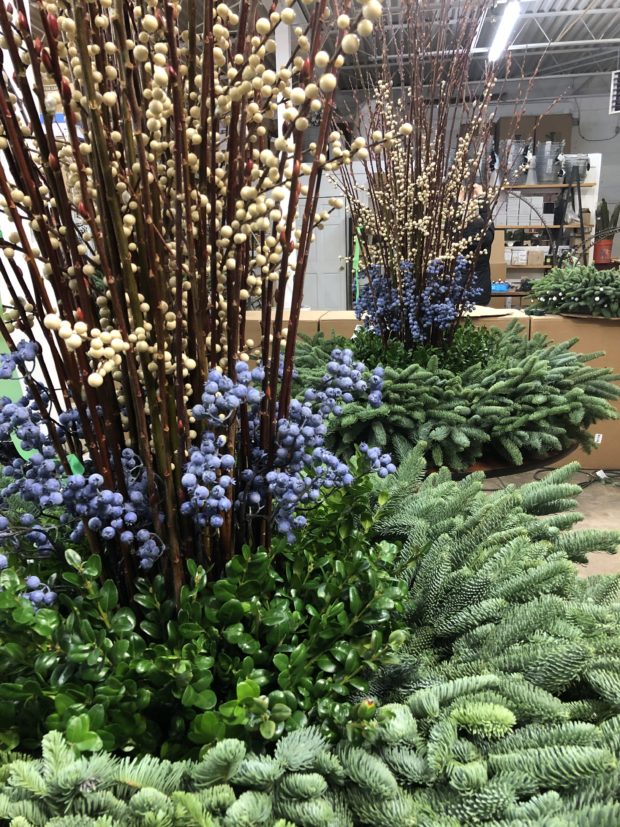 Not the least of my embarrassment of riches is a giant heated garage, with room to fabricate even the most complicated arrangements. Having a warm space to construct is the ultimate luxury. A bitterly cold environment is not an ideal place to work. Even an unheated garage provides shelter, so concentrating on the making is possible. I can always tell when my fabrication crew is focused on their work. The talk drops off, and I doubt they hear what is going on around them. Providing an environment that is friendly to the work is essential to what we do. I say that, as we do hundreds of winter container arrangements every season-in a fairly short period of time. We need a place to be to do all that.
Not the least of my embarrassment of riches is a giant heated garage, with room to fabricate even the most complicated arrangements. Having a warm space to construct is the ultimate luxury. A bitterly cold environment is not an ideal place to work. Even an unheated garage provides shelter, so concentrating on the making is possible. I can always tell when my fabrication crew is focused on their work. The talk drops off, and I doubt they hear what is going on around them. Providing an environment that is friendly to the work is essential to what we do. I say that, as we do hundreds of winter container arrangements every season-in a fairly short period of time. We need a place to be to do all that.
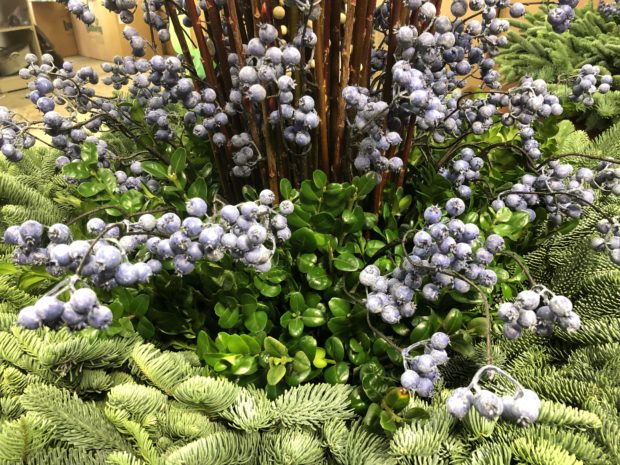 For those who do their own winter pots, it is possible to set up a temporary work station in a garage, or on an enclosed porch. Maybe there is a spot outdoors that is out of the wind. A decent place to work invariably results in more thoughtful work. It is likewise important to properly position the work. I would take the time to elevate the piece I am working on, rather than bend over it or sit on the floor. The set up time is time well spent. A favorite client has us lay down a tarp near her front door, and bring her pots inside. Once she has filled them, we take them back outside and place them. That service from us helps to enable her to enjoy making her winter pots. For pots that are impossibly heavy to move, consider constructing in a liner that can slip down into the pot, out of view. Anything done in too big a hurry tends to look hurried. Making the effort it takes to provide for a place to work indicates that the work has importance. This is why people have sewing rooms, music rooms, garden sheds and potting benches. They provide a place to work.
For those who do their own winter pots, it is possible to set up a temporary work station in a garage, or on an enclosed porch. Maybe there is a spot outdoors that is out of the wind. A decent place to work invariably results in more thoughtful work. It is likewise important to properly position the work. I would take the time to elevate the piece I am working on, rather than bend over it or sit on the floor. The set up time is time well spent. A favorite client has us lay down a tarp near her front door, and bring her pots inside. Once she has filled them, we take them back outside and place them. That service from us helps to enable her to enjoy making her winter pots. For pots that are impossibly heavy to move, consider constructing in a liner that can slip down into the pot, out of view. Anything done in too big a hurry tends to look hurried. Making the effort it takes to provide for a place to work indicates that the work has importance. This is why people have sewing rooms, music rooms, garden sheds and potting benches. They provide a place to work.
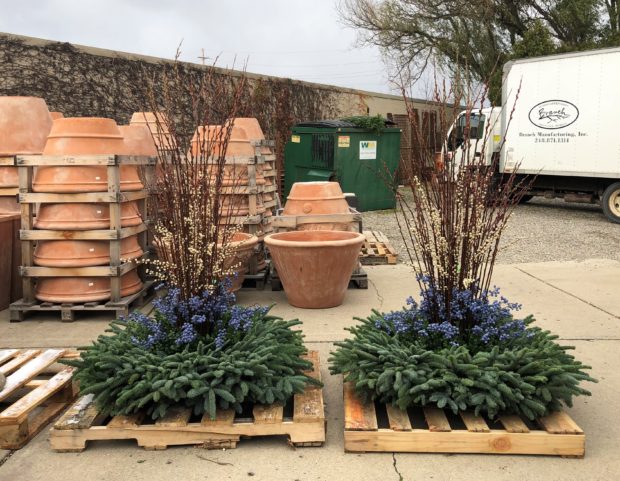 We did pop these centerpieces in their intended containers in short order. We do drive slender bamboo stakes down through the arrangement in 3 or 4 places, so a gust of wind does not carry them off. Larger and heavier centerpieces have a different construction protocol, which I will address in part 2.
We did pop these centerpieces in their intended containers in short order. We do drive slender bamboo stakes down through the arrangement in 3 or 4 places, so a gust of wind does not carry them off. Larger and heavier centerpieces have a different construction protocol, which I will address in part 2.
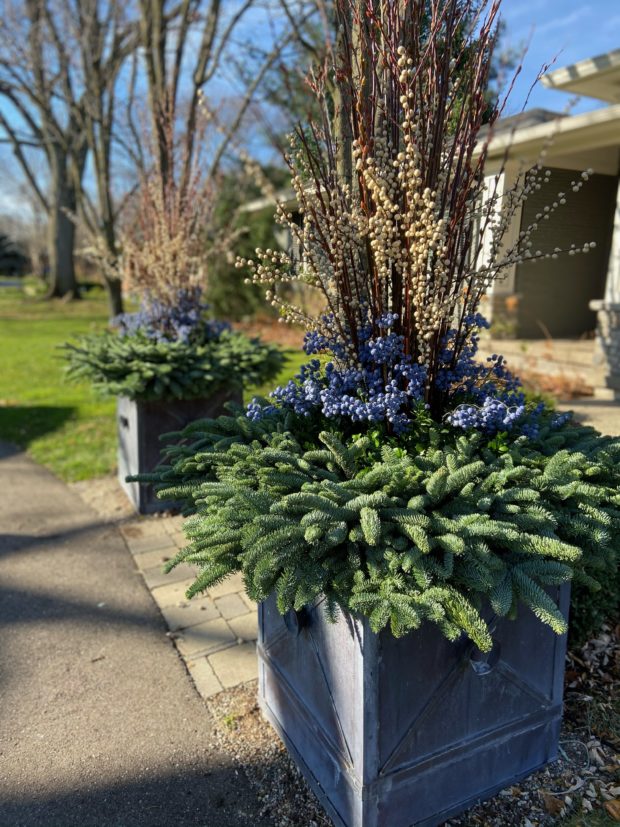 Our first container arrangement of the season, ready for winter.
Our first container arrangement of the season, ready for winter.
